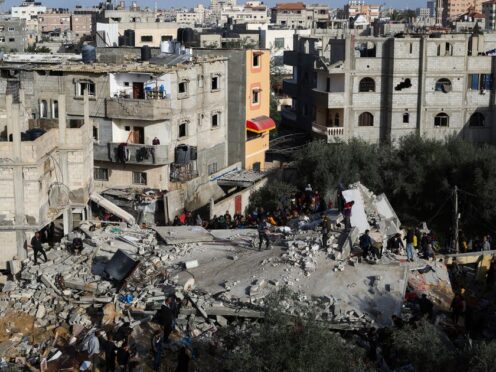
It took 10 years and three rounds of fertility treatment for Rania Abu Anza to become pregnant, and only seconds for her to lose her five-month-old twins in an Israeli air strike.
A strike hit the home of her extended family in the southern Gaza city of Rafah late on Saturday, killing her infant son and daughter, her husband and 11 other relatives and leaving another nine missing under the rubble, according to survivors and local health officials.
She had woken at around 10pm local time to feed Naeim, the boy, and went back to sleep with him in one arm and Wissam, the girl, in the other. Her husband was sleeping beside them.
The explosion came an hour-and-a-half later. The house collapsed.
“I screamed for my children and my husband,” she said on Sunday as she sobbed and cradled a baby’s blanket to her chest. “They were all dead. Their father took them and left me behind.”
She closed her eyes, leaned her head against the wall and patted the bundle in a calming gesture.
Israeli air strikes have regularly hit crowded family homes since the start of the war in Gaza, even in Rafah, which Israel declared a safe zone in October but is now the next target of its devastating ground offensive.

The strikes often come without warning, usually in the middle of the night.
Israel says it tries to avoid harming civilians and blames their deaths on the Hamas militant group because it positions fighters, tunnels and rocket launchers in dense residential areas. But the military rarely comments on individual strikes, which often kill women and children.
The military did not immediately comment on the strike in Rafah.
Of the 14 people killed in the Abu Anza house, six were children and four were women, according to Dr Marwan al-Hams, director of the hospital where the bodies were taken. In addition to her husband and children, Rania also lost a sister, a nephew and a pregnant cousin.
Farouq Abu Anza, a relative, said about 35 people were staying at the house, some of whom had been displaced from other areas. He said they were all civilians, mostly children, and there were no militants among them.
Rania and her husband, Wissam, both 29, spent a decade trying to get pregnant. Two rounds of IVF had failed, but after a third, she learned she was pregnant early last year. The twins were born on October 13.
Her husband, a labourer, was so proud he insisted on naming the girl after himself, she said.
“I didn’t get enough of them,” she said. “I swear I didn’t get enough of them.”
Less than a week before the twins were both, Hamas-led militants had stormed into southern Israel in a surprise attack, rampaging through communities, killing some 1,200 people – mostly civilians – and taking around 250 hostages, including children and a newborn.
Israel responded with one of the deadliest and most destructive military campaigns in recent history. The war has killed more than 30,000 Palestinians, according to Gaza’s Health Ministry. Around 80% of Gaza’s population of 2.3 million have fled their homes, and a quarter of the population faces starvation.
The ministry said last month that more than 12,300 Palestinian children and young teens had been killed in the war, about 43% of the overall toll. Women and children together make up three-quarters of those killed. The ministry does not differentiate between civilians and combatants in its tallies.
Israel claims to have killed more than 10,000 Hamas fighters but has not provided evidence.
For the children who survive, the war has made life hellish, humanitarian workers say, with some in northern Gaza beyond the reach of care.
“The sense of helplessness and despair among parents and doctors in realising that lifesaving aid, just a few miles away, is being kept out of reach, must be unbearable, but worse still are the anguished cries of those babies slowly perishing under the world’s gaze,” Unicef regional director Adele Khodr said in a statement on Sunday.
Until Saturday, the Abu Anza family had been relatively fortunate. Rafah has been spared the immense destruction of northern Gaza and the southern city of Khan Younis, where Israeli tanks and ground troops have fought militants block by block after waves of air strikes.
Rafah is also in the shrinking area of Gaza where humanitarian aid can still be delivered.
But Israel has said Rafah will be next, and the roughly 1.5 million people who have sought refuge there will be relocated, without saying where.
“We have no rights,” Rania said. “I lost the people who were dearest to me. I don’t want to live here. I want to get out of this country. I’m tired of this war.”

Enjoy the convenience of having The Sunday Post delivered as a digital ePaper straight to your smartphone, tablet or computer.
Subscribe for only £5.49 a month and enjoy all the benefits of the printed paper as a digital replica.
Subscribe